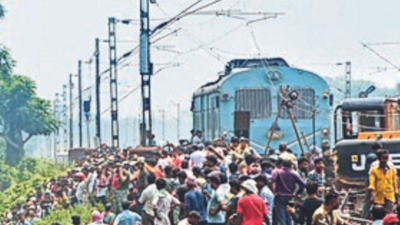- News
- City News
- bhubaneswar News
- Bahanaga train tragedy: How Odisha's past experience of dealing with cyclones, floods came in handy for rescue teams
Trending Topics
Bahanaga train tragedy: How Odisha's past experience of dealing with cyclones, floods came in handy for rescue teams

Locals worked through the night to help retrieve mangled bodies, ferried victims to hospitals and provided food and water to survivors
BHUBANESWAR: With the state being prone to natural disasters because of its geographical location, the Odisha government's past experience of dealing with cyclone and floods came in handy for the rescue teams to save around 1,200 lives from a near-death situation in the Bahanaga train tragedy on June 2, the government said on Monday.
The accident that left 275 passengers dead and over 1,000 injured was one of the worst disasters, though not natural, Odisha faced after the super cyclone in 1999, which had claimed over 10,000 lives. "Our state's disaster management mechanism improved a lot after the 1999 super cyclone. In the last 20 years, different agencies or departments of the government gained vast experience in handling disasters. This past experience and infrastructure like fire cutters, hydraulic lifters, lighting equipment and fast moving ambulances helped us save many lives at the Bahanaga train accident site," industries secretary Hemant Sharma, who was one of the many officers coordinating the rescue operation, said.
Over 4,000 passengers were travelling in the Coromandel Express and Bengaluru-Howrah Superfast Express. The Coromandel collided with a stationary goods train on the loop line and derailed. The derailed coaches veered off the track and hit the tail end of Bengaluru-Howrah train, which was crossing on the parallel line.
While 275 passengers involving the two trains died, around 1,200 injured were admitted to different hospitals. Government said the injured were rescued and rushed to nearby hospitals during the golden hour.
"The death toll would have been higher had the state government and its multiple agencies like Odisha fire service and Odisha disaster rapid action force not responded promptly. While the locals did a commendable job by carrying out the rescue operations, we mobilised all our resources and made advanced arrangements, especially the medical facilities in hospitals at Balasore, Soro, Bhadrak and Cuttack," said special relief commissioner Satyabrata Sahu.
Chief secretary Pradeep Kumar Jena said the disaster management mechanism of the state will be further strengthened with cutting-edge technology, training and capacity building of rescuers.
The accident that left 275 passengers dead and over 1,000 injured was one of the worst disasters, though not natural, Odisha faced after the super cyclone in 1999, which had claimed over 10,000 lives. "Our state's disaster management mechanism improved a lot after the 1999 super cyclone. In the last 20 years, different agencies or departments of the government gained vast experience in handling disasters. This past experience and infrastructure like fire cutters, hydraulic lifters, lighting equipment and fast moving ambulances helped us save many lives at the Bahanaga train accident site," industries secretary Hemant Sharma, who was one of the many officers coordinating the rescue operation, said.
Over 4,000 passengers were travelling in the Coromandel Express and Bengaluru-Howrah Superfast Express. The Coromandel collided with a stationary goods train on the loop line and derailed. The derailed coaches veered off the track and hit the tail end of Bengaluru-Howrah train, which was crossing on the parallel line.
While 275 passengers involving the two trains died, around 1,200 injured were admitted to different hospitals. Government said the injured were rescued and rushed to nearby hospitals during the golden hour.
"The death toll would have been higher had the state government and its multiple agencies like Odisha fire service and Odisha disaster rapid action force not responded promptly. While the locals did a commendable job by carrying out the rescue operations, we mobilised all our resources and made advanced arrangements, especially the medical facilities in hospitals at Balasore, Soro, Bhadrak and Cuttack," said special relief commissioner Satyabrata Sahu.
Chief secretary Pradeep Kumar Jena said the disaster management mechanism of the state will be further strengthened with cutting-edge technology, training and capacity building of rescuers.

About the Author
Debabrata MohapatraDebabrata Mohapatra is an Assistant Editor at The Times of India, Bhubaneswar. He had been writing for TOI from Puri since 2006 before joining the Bhubaneswar bureau in August 2010. He covers crime, law & order and Congress.
Start a Conversation
FOLLOW US ON SOCIAL MEDIA
FacebookTwitterInstagramKOO APPYOUTUBE










